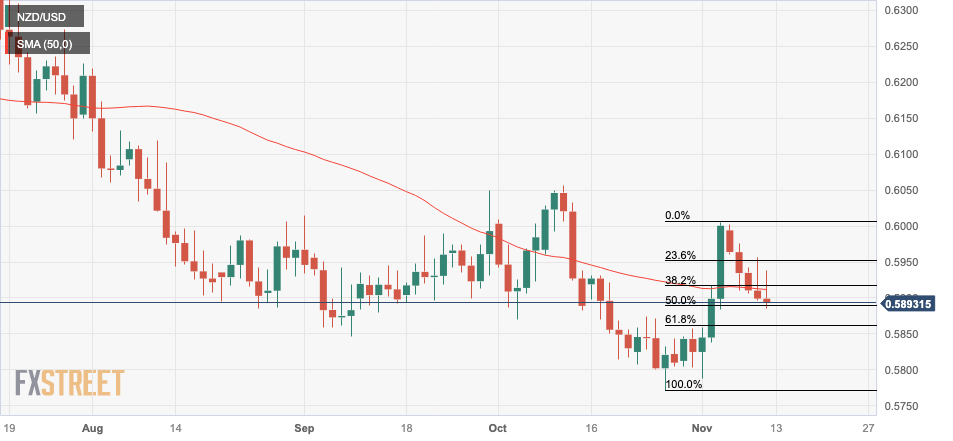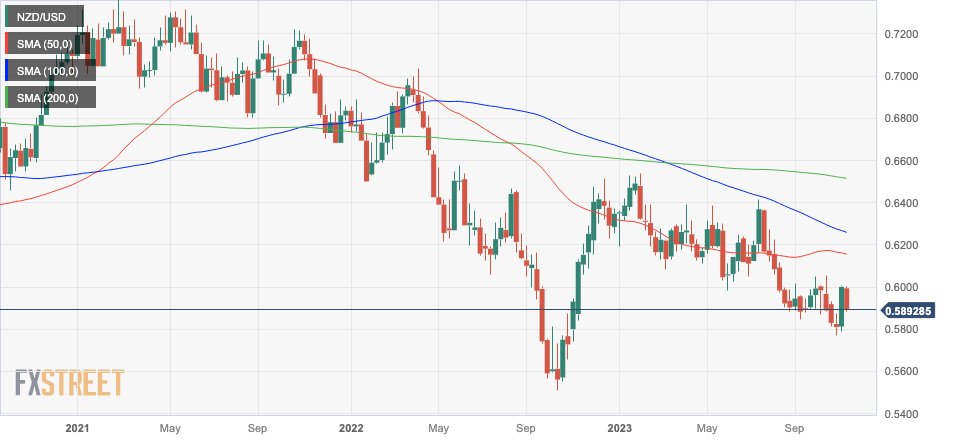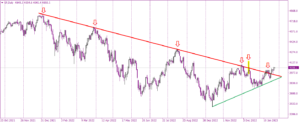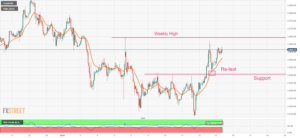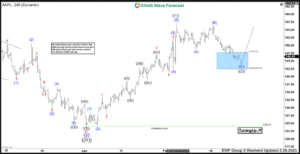- The New Zealand Dollar declines across the board on Friday but rebounds late in session.
- Kiwi weakness comes from a combination of a negative global growth outlook and US Dollar outperformance.
- Hawkish commentary from Fed Chair Powell set the US Dollar trending higher against the Kiwi, NZD/USD resumes decline.
The New Zealand Dollar (NZD) has spent most of Friday in a weak posture vis a vis the US Dollar (USD). That followed a run of weak data from China, New Zealand’s biggest trading partner. The NZD/USD pair, however, is moving in the Kiwi's favor late in the session as it rebounds from the $0.5880s to the $0.5890s.
NZD/USD fell much of the session as the US Dollar outperformed the Kiwi following a speech by Federal Reserve Chairman Jerome Powell on Thursday. Powell surprised markets by saying further rate hikes might be necessary to curb inflation. The USD rose on his remarks as higher interest rates could attract more foreign capital inflows, boosting demand for the buck.
Daily digest market movers: New Zealand Dollar falls on China data, Fedspeak
- The New Zealand Dollar trades lower against the US Dollar on Friday, reversing the previous day’s short-lived gains after a bounce off the 50-day Simple Moving Average (SMA).
- The pair fell after comments from Chairman Powell put interest rate hikes back on the table.
- The market had been lulled into expecting the Federal Reserve (Fed) to maintain the current level of the fed funds rate (5.25%-5-50%), but after Powell – and several other Fed officials – voiced dissatisfaction with the current level of tightening, the market view is shifting to potentially seeing further hikes.
- Downbeat Chinese inflation data has dampened the outlook for global growth. This weighs directly on NZD, as it is a major commodity exporter – especially of dairy products – to China.
- The Kiwi itself weakened midweek on the back of an inflation report from the RBNZ that showed both one-year-out and two-years-out inflation expectations for New Zealand falling in Q3 compared to the previous quarter.
- The lower inflation expectations imply the RBNZ is less likely to raise interest rates.
New Zealand Dollar technical analysis: NZD/USD threatens more downside
NZD/USD – the number of US Dollars one New Zealand Dollar can buy – reversed its bounce and then broke below the 50-day SMA on Friday. Previous to that it had used the SMA as a springboard for intraday gains.
New Zealand Dollar vs US Dollar: Daily Chart
The bullish short-term trend is now seriously at risk of reversing. The pair trades at 0.5890 at the time of writing, only a few pips above the last major lower high of the previous uptrend, at 0.5874, made on November 2. A break below would probably indicate a reversal and deeper losses.
The next target to the downside would probably be at 0.5862, where the 61.8% Fibonacci retracement of the recovery from the year-to-date lows in late October and early November. The main target, however, sits at 0.5790.
A recovery and decisive break above the November 3 high at 0.6001, however, would reconfirm this bullish bias, with a likely target thereafter at the 0.6055 October high.
The medium and long-term trends are still bearish, suggesting the potential for more downside is strong.
New Zealand Dollar vs US Dollar: Weekly Chart
Bulls would have to push above the 0.6055 October high to change the outlook in the medium term and suggest the possibility of the birth of a new uptrend.
New Zealand Dollar FAQs
The New Zealand Dollar (NZD), also known as the Kiwi, is a well-known traded currency among investors. Its value is broadly determined by the health of the New Zealand economy and the country’s central bank policy. Still, there are some unique particularities that also can make NZD move. The performance of the Chinese economy tends to move the Kiwi because China is New Zealand’s biggest trading partner. Bad news for the Chinese economy likely means less New Zealand exports to the country, hitting the economy and thus its currency. Another factor moving NZD is dairy prices as the dairy industry is New Zealand’s main export. High dairy prices boost export income, contributing positively to the economy and thus to the NZD.
The Reserve Bank of New Zealand (RBNZ) aims to achieve and maintain an inflation rate between 1% and 3% over the medium term, with a focus to keep it near the 2% mid-point. To this end, the bank sets an appropriate level of interest rates. When inflation is too high, the RBNZ will increase interest rates to cool the economy, but the move will also make bond yields higher, increasing investors’ appeal to invest in the country and thus boosting NZD. On the contrary, lower interest rates tend to weaken NZD. The so-called rate differential, or how rates in New Zealand are or are expected to be compared to the ones set by the US Federal Reserve, can also play a key role in moving the NZD/USD pair.
Macroeconomic data releases in New Zealand are key to assess the state of the economy and can impact the New Zealand Dollar’s (NZD) valuation. A strong economy, based on high economic growth, low unemployment and high confidence is good for NZD. High economic growth attracts foreign investment and may encourage the Reserve Bank of New Zealand to increase interest rates, if this economic strength comes together with elevated inflation. Conversely, if economic data is weak, NZD is likely to depreciate.
The New Zealand Dollar (NZD) tends to strengthen during risk-on periods, or when investors perceive that broader market risks are low and are optimistic about growth. This tends to lead to a more favorable outlook for commodities and so-called ‘commodity currencies’ such as the Kiwi. Conversely, NZD tends to weaken at times of market turbulence or economic uncertainty as investors tend to sell higher-risk assets and flee to the more-stable safe havens.
- SEO Powered Content & PR Distribution. Get Amplified Today.
- PlatoData.Network Vertical Generative Ai. Empower Yourself. Access Here.
- PlatoAiStream. Web3 Intelligence. Knowledge Amplified. Access Here.
- PlatoESG. Carbon, CleanTech, Energy, Environment, Solar, Waste Management. Access Here.
- PlatoHealth. Biotech and Clinical Trials Intelligence. Access Here.
- Source: https://www.fxstreet.com/news/new-zealand-dollar-weakens-on-global-growth-outlook-fedspeak-202311101310
- :has
- :is
- :where
- 2%
- 32
- 35%
- 7
- 8
- a
- About
- above
- Achieve
- across
- After
- against
- aims
- also
- among
- an
- analysis
- and
- Animate
- Another
- appeal
- appropriate
- ARE
- AS
- assess
- Assets
- At
- Attempts
- attract
- Attracts
- average
- back
- Bad
- Bank
- based
- BE
- bearish
- because
- been
- below
- between
- bias
- Biggest
- birth
- board
- bond
- Bond yields
- boost
- boosting
- both
- Bounce
- Break
- broad
- broader
- broadly
- Broke
- Bullish
- but
- buy
- by
- CAN
- capital
- central
- Central Bank
- Chair
- chairman
- change
- China
- chinese
- combination
- comes
- Commentary
- comments
- Commodities
- commodity
- compared
- confidence
- content
- contrary
- contributing
- conversely
- Cool
- could
- country
- country’s
- Currency
- Current
- daily
- dairy
- data
- decisive
- Decline
- Declines
- deeper
- Demand
- depreciate
- Despite
- determined
- Digest
- directly
- Dollar
- dollars
- downside
- during
- Earlier
- Early
- Economic
- Economic growth
- economic uncertainty
- economy
- elevated
- encourage
- end
- ends
- especially
- expanded
- expectations
- expected
- expecting
- export
- exports
- factor
- Falling
- Falls
- FAQ
- favor
- favorable
- Fed
- Fed Chair
- Fed Chair Powell
- fed funds rate
- Federal
- federal reserve
- few
- Focus
- following
- For
- foreign
- foreign investment
- Friday
- from
- funds
- further
- Gains
- Global
- good
- Growth
- had
- Have
- Health
- High
- higher
- Hikes
- his
- hitting
- How
- However
- HTTPS
- if
- Impact
- in
- Income
- Increase
- increasing
- indicate
- industry
- inflation
- Inflation expectations
- inflation rate
- inflows
- interest
- INTEREST RATE
- INTEREST RATE HIKES
- Interest Rates
- into
- Invest
- investment
- Investors
- IT
- ITS
- itself
- jerome
- Keep
- Key
- known
- Last
- Late
- lead
- less
- Level
- likely
- long-term
- Long-Term Trends
- losses
- Low
- lower
- Lows
- made
- Main
- maintain
- major
- make
- Market
- Markets
- May..
- means
- medium
- might
- module
- more
- most
- move
- Movers
- moving
- moving average
- much
- Near
- necessary
- negative
- New
- New Zealand
- news
- next
- November
- now
- number
- NZD
- NZD/USD
- october
- of
- off
- officials
- on
- ONE
- ones
- only
- Optimistic
- or
- Other
- Outlook
- over
- pair
- partner
- performance
- periods
- plato
- Plato Data Intelligence
- PlatoData
- Play
- policy
- possibility
- potential
- potentially
- Powell
- previous
- Prices
- probably
- Products
- Push
- put
- Q3
- Quarter
- raise
- Rate
- rate hikes
- Rates
- RBNZ
- rebound
- recovery
- Releases
- report
- Reserve
- reserve bank
- Reserve Bank of New Zealand
- retracement
- Reversal
- Risk
- risks
- Role
- ROSE
- Run
- s
- safe
- saying
- seeing
- sell
- seriously
- session
- set
- Sets
- several
- SHIFTING
- short-term
- showed
- Simple
- sits
- SMA
- some
- speech
- spent
- starts
- State
- Still
- strength
- Strengthen
- strong
- such
- suggest
- surprised
- table
- Target
- Technical
- Technical Analysis
- tends
- term
- that
- The
- the Fed
- The State
- The US Federal Reserve
- then
- There.
- this
- threatens
- thursday
- Thus
- tightening
- time
- times
- to
- together
- too
- traded
- trades
- Trading
- Trend
- trending
- Trends
- turbulence
- Uncertainty
- unemployment
- unique
- uptrend
- us
- US Dollar
- US Dollars
- US Federal
- us federal reserve
- USD
- used
- Valuation
- value
- View
- vs
- weakness
- weekly
- weighs
- well-known
- when
- will
- with
- would
- writing
- yields
- Zealand
- zephyrnet

